Race marking
| Author | Date | Message |
|---|---|---|
| Alan Ayling | Mar 4 2019, 11:33pm | Worth everyone's time having a look at the official version of how course marking works, or at least is supposed to. Click the CONSTITUTION link at the bottom of the IMRA page, then the Competition Rules link. In the Appendix of that fine document are the guidelines for course marking, complete with diagrams. The volunteers marking the courses try to stick to the guidelines, all runners should also be familiar so they know what they should be looking out for. |
| Mick Hanney | Mar 5 2019, 9:23am | A timely post given recent events and with Maulin around the corner :-) |
| Peter O'Farrell | Mar 5 2019, 10:19am | The other way to see the race guidelines is to; Click the "volunteer" tab Click "race marker" Click the words "race marking guidelines" This downloads the race marking word document. |
| Stephen Brennan | Mar 5 2019, 3:37pm | At the risk of opening a can of worms: Last Saturday's race at Ticknock had a good portion of the field miss the right turn into the forest on the descent from Two Rock. This turn was noted in route description and marked according to the guidelines. This was a case where blocking tape might have worked. I took the correct route - the single track though the forest was one of the best parts of the course. In any event, it was a very enjoyable race. It was gas looking at it afterwards on Flyby! :) |
| Peter O'Farrell | Mar 5 2019, 3:57pm | It's a great point and would undoubtedly work very well. The guidelines are due for their review and blocking tape might get the nod. Or not. The counter argument is two fold; 1: Only have tape where you want people to go 2: On a windy day a long piece of blocking tape can easily a very long fluttering marker drawing people the wrong way Of the two points the first point is fundamental. Only have tape where you want to go and only use tape where people can go the wrong way. Therefore no tape along single track where the runner can't go anywhere, no "re-assurance" tape except within the first 50m after a junction. The current guidelines suggest the need for arrows and/or a marshall at those difficult left or right turns off a bigger path, the previous turn had a marshall in fairness. |
| Paul Joyce | Mar 8 2019, 10:39pm | The marking guidelines are great for general guidance, but to be honest they are rather abstract and sometimes race junctions need to be specific. I've marked and also ran a few races, sometimes making errors, sometimes not, but in general I've found the following "rules" to work: 1. Mark a junction how you think a race leader will read it, at speed and wearing raceface. Remove any ambiguity- leaders are working hard enough and every junction should be immediately obvious to turn or not. If you consider the effectiveness of course marking and the leader goes astray... 2. Blocking tape is often necessary, and immediately obvious. It has far more benefit than the few times wind may cut the tape. If in doubt on exposed areas, two individual lengths, to be sure to be sure. 3. Points one and two carry double if you are marking a fast downhill section. 4. Ignore global warming or any environment issues with plastic tape when marking. Tape has a function, so immediately bin any "second hand" tape and don't spare the fresh plastic roll when marking. 5. If you have enough volunteers, re-check the marked route on race morning, if parts have been marked the night before. 6. Those lovely reusable IMRA arrows that can be staked in the ground remove any ambiguity and are ideal for contentious junctions. 7. Anyone complaining about their race result who went wrong following the "flock"... if your volunteer record shows previous race marker, your complaint can be taken seriously, otherwise... 8. Unmarked races are much more fun all round ;) |
| Gordon Place | Mar 8 2019, 11:48pm | Whatever about the rest, and breaking out the new tape for blocking, can't agree with point 4, having marked with second hand tape with no issue. Provided not trying to use 2 inch scraps |
| Alan Ayling | Mar 9 2019, 6:15pm | Paul - some very good points. Might I respectfully suggest that blocking tape should be used as rarely as possible? When nothing else will do, the sort of place you'd rather put a marshal but know you won't have one spare. Blocking tape should NOT be the norm. We used to do that years ago and it led to all sorts of problems. I don't mind its occasional use when genuinely necessary. Should be ideally along the ground, weighed with stones etc, not up at a height. |

